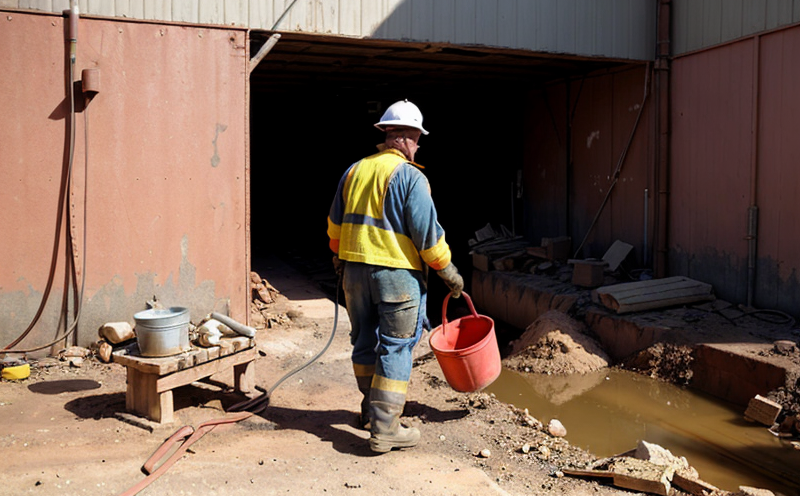MSHA Mine Noise Exposure Compliance Testing
The Mine Safety and Health Administration (MSHA) regulations are designed to protect miners from hazards in their working environment, including the risk of noise-induced hearing loss. To ensure compliance with MSHA regulations regarding mine noise exposure, testing is critical. Our service focuses on providing comprehensive noise exposure assessments that meet strict regulatory requirements.
The Occupational Noise Exposure Standard (29 CFR 1910.95) sets permissible noise levels for workers in mining environments to prevent hearing damage from excessive sound levels. This standard mandates the use of personal protective equipment (PPE), hearing conservation programs, and regular noise monitoring. Compliance with these standards is essential to maintaining a safe work environment and avoiding potential legal issues.
The process begins by selecting appropriate sampling locations within the mine based on known or suspected high-exposure areas. These might include drill sites, rock loading stations, and other equipment operation points where workers are frequently present. Once identified, we deploy calibrated sound level meters to measure noise levels continuously over a predetermined period.
Data collected from these measurements is then analyzed according to MSHA standards. This involves comparing the measured decibel (dB) values against permissible exposure limits defined in 29 CFR 1910.95, which vary based on duration of exposure. For example, an eight-hour time-weighted average (TWA) limit may be exceeded if workers are exposed to noise levels above 85 dB for extended periods.
Based on the analysis, our team prepares detailed reports outlining areas that exceed permissible limits and recommend corrective actions such as implementing engineering controls like mufflers or administrative measures like reducing exposure time. Additionally, we provide guidance on selecting appropriate PPE based on individual worker needs determined through our testing process.
Our expertise lies not just in the technical aspects of conducting noise measurements but also ensuring that all findings are presented clearly and concisely within the context of MSHA regulations. This includes preparing reports tailored to meet specific client requirements, whether for internal use by management or submission to regulatory bodies like MSHA itself.
By providing accurate and reliable data regarding mine noise exposures, we help mining companies stay compliant with federal laws while enhancing overall worker safety. Our services go beyond mere compliance; they contribute positively towards creating healthier working conditions which ultimately lead to higher productivity levels among employees who can hear better and work safer without fear of long-term health risks.
To summarize, our MSHA Mine Noise Exposure Compliance Testing service offers a robust solution for ensuring adherence to safety standards set forth by the Mine Safety and Health Administration. Through precise measurement techniques, thorough analysis, and actionable recommendations, we support mining operations in achieving both regulatory compliance and improved operational efficiency.
Benefits
- Ensures strict adherence to MSHA regulations regarding permissible noise levels in mines.
- Reduces the risk of hearing impairment among workers due to prolonged exposure to high sound levels.
- Promotes a safer working environment by identifying and addressing potential hazards early on.
- Aids in compliance with occupational health standards, thereby avoiding penalties associated with non-compliance.
- Supports the implementation of effective hearing conservation programs aimed at protecting workers' long-term auditory health.
Customer Impact and Satisfaction
Our clients benefit from our MSHA Mine Noise Exposure Compliance Testing service in several ways. Firstly, by providing accurate data about noise levels within mines, we enable them to make informed decisions regarding necessary safety measures. Secondly, through our recommendations for improvements based on test results, mining companies can enhance their occupational health and safety practices, leading to increased worker satisfaction.
Customers also appreciate the clarity of our reports which help them communicate effectively with regulatory bodies like MSHA. The detailed insights into compliance status provide peace of mind knowing that all necessary steps have been taken to protect workers' hearing. Furthermore, by helping mines achieve and maintain compliance, we contribute to a positive reputation for responsible corporate citizenship.
Ultimately, our service enhances customer satisfaction by ensuring that mining operations operate within legal guidelines while fostering a culture of safety and health awareness among employees. This holistic approach not only meets regulatory requirements but also supports long-term business sustainability through reduced risk exposure and improved productivity.
Competitive Advantage and Market Impact
In today's competitive market, maintaining a safe work environment is crucial for attracting and retaining top talent. By offering MSHA Mine Noise Exposure Compliance Testing services, our clients gain several strategic advantages:
- We help companies stay ahead of regulatory changes by providing up-to-date information on permissible noise levels.
- Our expertise ensures that mining operations remain compliant with international standards such as ISO 19106:2015, enhancing their reputation for quality and reliability.
- The data we provide can be used to demonstrate commitment to employee welfare, which is increasingly important in attracting investors and maintaining a good public image.
- Through our recommendations for improving safety protocols, companies can differentiate themselves from competitors who may not prioritize worker health as much. This sets the stage for sustainable competitive advantage over time.
By integrating these services into their operations, mining firms demonstrate their commitment to responsible corporate practices, which can positively influence market perception and drive growth in a highly regulated industry.





